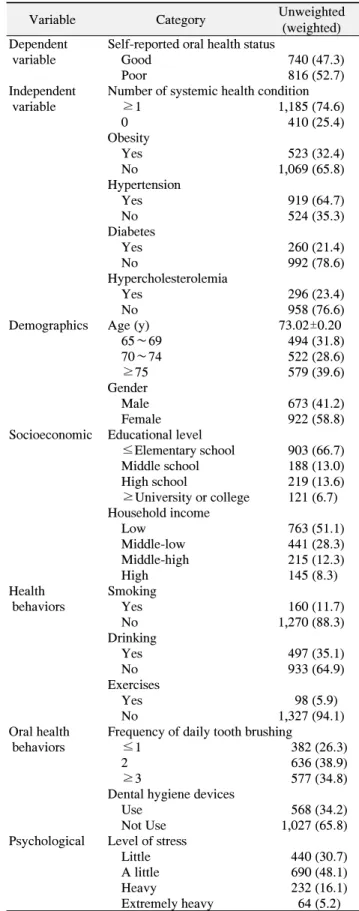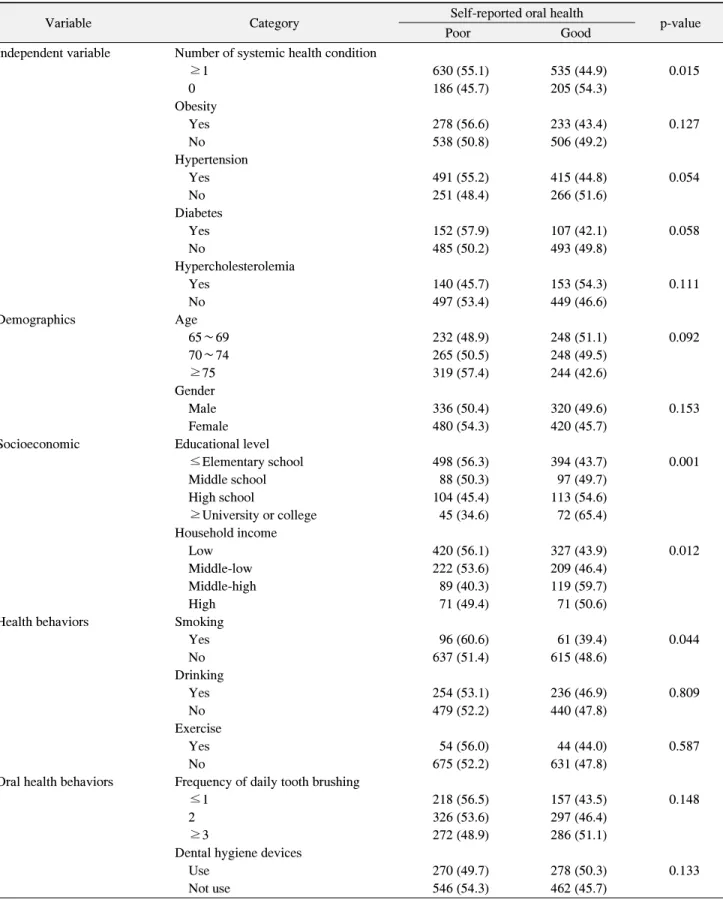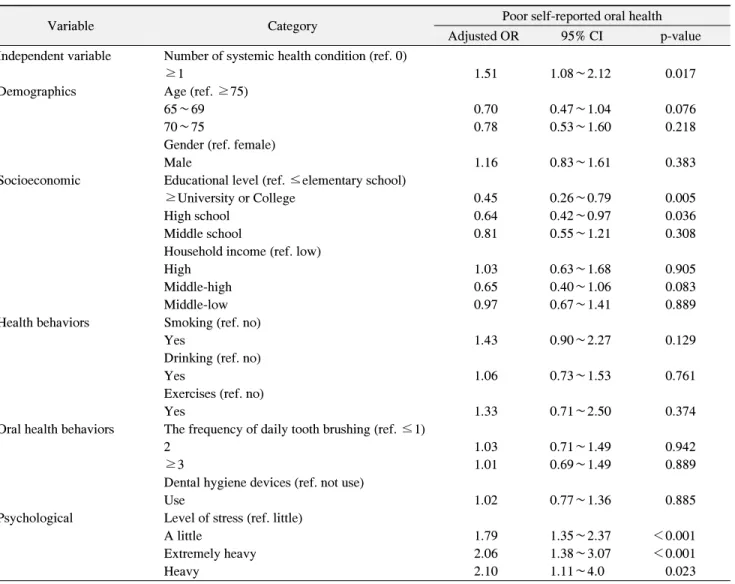RESEARCH ARTICLE
Received: November 11, 2016, Revised: January 7, 2017, Accepted: January 10, 2017 ISSN 1598-4478 (Print) / ISSN 2233-7679 (Online)
†
Correspondence to: Hae-Young Kim
Department of Health Policy and Management, College of Health Sciences, Korea University, 145 Anam-ro, Seongbuk-gu, Seoul 02841, Korea Tel: +82-2-3290-5667, Fax: +82-2-940-2879, E-mail: kimhaey@korea.ac.kr
Copyright © 2017 by Journal of Dental Hygiene Science
한국노인의 전신건강상태와 주관적 구강건강 관련성
최은실
1
ㆍ유지영2
ㆍLauren L. Patton3
ㆍ김혜영1,4†
1
고려대학교 대학원 보건과학과 BK21+인간생명-사회환경 상호작용 융합사업단,2
중앙치매센터,3
노스캐롤라이나 대학교 치과대학,4
고려대학교 보건과학대학 보건정책관리학부Association between Systemic Health Conditions and Self-Reported Oral Health in Korean Elderly
Eun Sil Choi 1 , Jiyoung Lyu 2 , Lauren L. Patton 3 , and Hae-Young Kim 1,4†
1
BK21 PLUS Program in Embodiment: Health-Society Interaction, Department of Public Health Sciences, Graduate School, Korea University, Seoul 02841,
2
National Institute of Dementia, Seongnam 13494, Korea
3
Department of Dental Ecology, School of Dentistry, University of North Carolina, Chapel Hill, NC 27599, USA,
4
Department of Health Policy and Management, College of Health Sciences, Korea University, Seoul 02841, Korea
Systemic health conditions increase with advancing age, and may be linked to poor self-reported oral health. The purpose of this study was to evaluate the association between systemic health conditions and poor self-reported oral health among Korean elderly. The study used a nationally representative sample of Koreans (2012 Korea National Health and Nutrition Examination Survey) aged 65∼98 years (n=1,595). Systemic health conditions in this population were assessed by the presence of one or more of the following conditions: obesity, hypertension, diabetes, and hypercholesterolemia. The relative risk of poor self-reported oral health according to the occurrence of systemic health conditions was estimated by multivariate logistic regression after controlling for several potential confounders (i.e., socio-demographic factors, oral health behaviors, health behaviors, and psychological factors). After adjustment for these confounders, the relative risk of having poor self-reported oral health was greater among the elderly with one or more systemic health conditions than in those without a systemic health condition. The odds ratio of having poor self-reported oral health according to the occurrence of systemic health conditions was 1.51 (95% confidence interval, 1.08∼2.12). Among the Korean elderly, perception of poor oral health was associated with the presence of one or more systemic health conditions. Future studies are needed to examine the detailed causal relation between systemic health conditions and poor oral health longitudinally.
Key Words: Aged, Health, Oral health
Introduction
Korea has the most rapidly aging population worldwide.
In 2013, the number of older people in Korea accounted for 12.2% of its entire population. This trend is projected to continue and may result in a super-aged society by 2026 1) . Despite the positive effects of increased life expec-
tancy, an aging population suffering from systemic health
conditions can be problematic for the society 2) . Health
care costs related to the treatment and management of
systemic health conditions in the elderly are expected to
surge, which may deteriorate elderly health-related quality
of life 3) . Poor systemic health conditions can cause blood
clots and inflammation, and may lead to serious global
health problems 4) .
The association between systemic health conditions and oral health has been examined in many studies 5-19) . Indi- viduals with systemic health condition such as obesity, diabetes, hypertension, and hypercholesterolemia were found to have higher risk of developing periodontal dis- ease than those without systemic health conditions 5-12) . In addition, obesity was associated with tooth loss among elderly aged 70 years and over 1 13-15) . Longitudinal studies also revealed a causal relationship that people with obesity were more likely to develop periodontal disease 16,17) .
Although previous studies have examined the asso- ciation between specific systemic health condition and oral health, this association should be investigated more comprehensively when examining elderly. Comorbidity is more common among elderly, and it has an even bigger impact on oral health due to its association with infla- mmation 18,20,21) . Therefore, examining comorbidity systemic condition and oral health is suggested.
A comprehensive measuring of elderly oral health state is not simple because the effect of previous oral diseases such as dental caries or periodontal disease eventually results in the loss of multiple teeth for the severe cases. A global rating of self-reported oral health has been widely used as a simple and effective subjective measure of general oral health status 13,22) . Especially for elderly, using self-reported oral health measure is meaningful because the collective evaluation of the history of their oral diseases and treatment accumulated for the whole life can be assessed including missing teeth state and all other oral diseases present 13,23) . As the self-reported evaluation of perceived oral health status was reported to be signi- ficantly related to the objective measurement, perceived oral health status is considered to represent the oral health status of the elderly 24,25) . Therefore, self-reported oral health can be a comprehensive measure of a person’s complete oral health condition and periodontal disease status.
According to previous studies, demographic factors (e.g., age, gender), socioeconomic factors (e.g., education, income), overall health behaviors (e.g., smoking, drinking, exercise), oral health behaviors (e.g., frequency of daily tooth brushing, use of dental hygiene devices), and
psychological factors (e.g., stress) have been reported to have association with individual’s oral health status 26) . Additionally, the overall physical health is closely tied to oral health 27) .
Although systemic health condition is a more urgent and important issue among elderly, studies examining the association between systemic health conditions and self-reported oral health among elderly is scarce. There- fore, the present study utilized the nationally represen- tative sample data from the 2012 Korea National Health and Nutrition Examination Survey (KNHANES) to in- vestigate the potential link between systemic health conditions and self-reported oral health in elderly. The purpose of this study was to evaluate the relationship between systemic health conditions and self-reported oral health among Korean elderly.
Materials and Methods
1. Study design and participants
KNHANES is a continuous cross-sectional survey for the non-institutionalized civilian of South Korea. In this survey, we used a complex stratified multistage stochastic sampling design based on age, sex, region to represent the Korean population. KNHANES-Ⅳ (2012), coordinated by the Korean Ministry of Health and Welfare, includes items based on oral examination and health interview surveys 28) . This survey was approved by the Institutional Review Board of the Korea Centers for Disease Control and Prevention, and all participants agreed in writing. Our study was approved by the Korea University Institutional Review Board (KU-IRB-16-EX-111-A-1). We analyzed a total of 1,595 subjects aged 65 and over who completed the 2012 KNHANES.
2. Data collection
Dependent variable is self-reported oral health statue.
“How would you describe the state of your teeth and gums?” The participants were asked to rate their oral health from these five aspects in comparison with their peers using a two-level scale, very good, good, average is
‘good,’ and poor, very poor is ‘poor.’ Besides self-re-
ported oral health conditions.
Table 1. Study Participants’ Characteristics
Variable Category Unweighted
(weighted) Dependent Self-reported oral health status
variable Good 740 (47.3)
Poor 816 (52.7)
Independent Number of systemic health condition
variable ≥1 1,185 (74.6)
0 410 (25.4)
Obesity
Yes 523 (32.4)
No 1,069 (65.8)
Hypertension
Yes 919 (64.7)
No 524 (35.3)
Diabetes
Yes 260 (21.4)
No 992 (78.6)
Hypercholesterolemia
Yes 296 (23.4)
No 958 (76.6)
Demographics Age (y) 73.02±0.20
65∼69 494 (31.8)
70∼74 522 (28.6)
≥75 579 (39.6)
Gender
Male 673 (41.2)
Female 922 (58.8)
Socioeconomic Educational level
≤Elementary school 903 (66.7) Middle school 188 (13.0)
High school 219 (13.6)
≥University or college 121 (6.7) Household income
Low 763 (51.1)
Middle-low 441 (28.3)
Middle-high 215 (12.3)
High 145 (8.3)
Health Smoking
behaviors Yes 160 (11.7)
No 1,270 (88.3)
Drinking
Yes 497 (35.1)
No 933 (64.9)
Exercises
Yes 98 (5.9)
No 1,327 (94.1)
Oral health Frequency of daily tooth brushing
behaviors ≤1 382 (26.3)
2 636 (38.9)
≥3 577 (34.8)
Dental hygiene devices
Use 568 (34.2)
Not Use 1,027 (65.8)
Psychological Level of stress
Little 440 (30.7)
A little 690 (48.1)
Heavy 232 (16.1)
Extremely heavy 64 (5.2) Values are presented as unweighted n (weighted %) or mean±
standard deviation.
Systemic health conditions occurrence was assessed with having one or more of the following conditions:
obesity, hypertension, diabetes, and hypercholesterolemia.
Obesity was assessed with overweight. If the body mass index was greater than or equal to 25 kg/m 2 , respondents were defined as having obesity. Hypertension was asse- ssed with systolic blood pressure (greater than 140 mmHg) or diastolic blood pressure (greater than 90 mmHg), or whether the respondent took blood pressure medication.
Diabetes was assessed if respondents had greater than or equal to 126 mg/dl fasting glucose, or took diabetes medi- cation. Hypercholesterolemia was assessed if respondents had greater than or equal to 240 mg/dl fasting total cho- lesterol, or took cholesterol-lowering medication 18) .
Demographic factors included age (65∼69, 70∼74, 75 and over years) and gender (male, female). Socioeconomic factors included education level (lower than elementary school, middle school, high school, upper university or college) and household income (in quartiles). Health beha- viors included smoking (yes, no), drinking alcohol (yes, no), and exercise (yes, no). Oral health behaviors included frequency of daily tooth brushing (≤1, 2, ≥3), and using a dental hygiene device included dental floss, interdental brush, mouth rinse, electric toothbrush etc. (yes, no).
Psychological factors included the level of stress was measured using the question “How much stress do you feel in your normal life?” and was scored on a 4 point scale (little, a little, heavy, extremely heavy).
3. Statistical analysis
The analysis was based on the sampling weights acco-
unting for complex sampling design of KNHANES. Com-
plex sampling method were used to all analysis the data. A
bivariate relationship between study participants’ charac-
teristics and self-reported oral health was examined using
the chi-square test. A multivariate logistic regression was
conducted to investigate the relationship between indi-
vidual systemic conditions and self-reported oral health
adjusted for covariation. Each systemic condition was
obesity, hypertension, diabetes, hypercholesterolemia and
self-reported oral health adjusted for covariation (Model
I∼IV). A multivariate logistic regression was conducted
to investigate the relationship between systemic health
Table 2. Bivariate Association between Self-Reported Oral Health Status and Other Related Factors
Variable Category Self-reported oral health
p-value
Poor Good
Independent variable Number of systemic health condition
≥1 630 (55.1) 535 (44.9) 0.015
0 186 (45.7) 205 (54.3)
Obesity
Yes 278 (56.6) 233 (43.4) 0.127
No 538 (50.8) 506 (49.2)
Hypertension
Yes 491 (55.2) 415 (44.8) 0.054
No 251 (48.4) 266 (51.6)
Diabetes
Yes 152 (57.9) 107 (42.1) 0.058
No 485 (50.2) 493 (49.8)
Hypercholesterolemia
Yes 140 (45.7) 153 (54.3) 0.111
No 497 (53.4) 449 (46.6)
Demographics Age
65∼69 232 (48.9) 248 (51.1) 0.092
70∼74 265 (50.5) 248 (49.5)
≥75 319 (57.4) 244 (42.6)
Gender
Male 336 (50.4) 320 (49.6) 0.153
Female 480 (54.3) 420 (45.7)
Socioeconomic Educational level
≤Elementary school 498 (56.3) 394 (43.7) 0.001
Middle school 88 (50.3) 97 (49.7)
High school 104 (45.4) 113 (54.6)
≥University or college 45 (34.6) 72 (65.4)
Household income
Low 420 (56.1) 327 (43.9) 0.012
Middle-low 222 (53.6) 209 (46.4)
Middle-high 89 (40.3) 119 (59.7)
High 71 (49.4) 71 (50.6)
Health behaviors Smoking
Yes 96 (60.6) 61 (39.4) 0.044
No 637 (51.4) 615 (48.6)
Drinking
Yes 254 (53.1) 236 (46.9) 0.809
No 479 (52.2) 440 (47.8)
Exercise
Yes 54 (56.0) 44 (44.0) 0.587
No 675 (52.2) 631 (47.8)
Oral health behaviors Frequency of daily tooth brushing
≤1 218 (56.5) 157 (43.5) 0.148
2 326 (53.6) 297 (46.4)
≥3 272 (48.9) 286 (51.1)
Dental hygiene devices
Use 270 (49.7) 278 (50.3) 0.133
Not use 546 (54.3) 462 (45.7)
Table 2. Continued
Variable Category Self-reported oral health
p-value
Poor Good
Psychological Level of stress <0.001
Little 190 (42.6) 241 (57.4)
A little stress 362 (54.8) 321 (45.2)
Heavy 140 (61.9) 88 (38.1)
Extremely heavy 39 (60.7) 24 (39.3)
Values are presented as unweighted n (weighted %).
p-value was by chi-square test.
Table 3. Multivariate Association between Poor Self-Reported Oral Health and Individual Systemic Health Condition under Adjustment for Other Related Factors
Individual systemic health condition Poor self-reported oral health
Adjusted OR
a95% CI p-value
Model I Obesity (ref. no) 1.38 1.01∼1.87 0.041
Model II Hypertension (ref. no) 1.31 0.99∼1.74 0.059
Model III Diabetes (ref. no) 1.29 0.92∼1.81 0.141
Model IV Hypercholesterolemia (ref. no) 0.75 0.50∼1.12 0.153
Dependent variable: self-reported oral health status (ref. good).
OR: odds ratio, CI: confidence interval.
a



